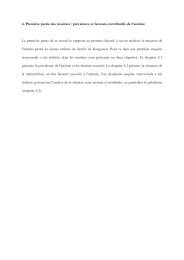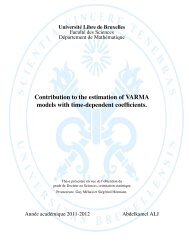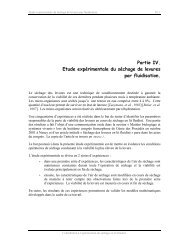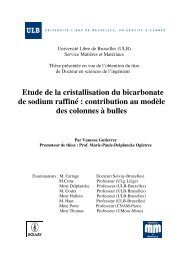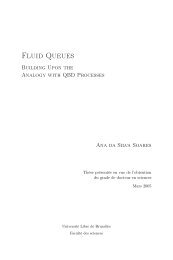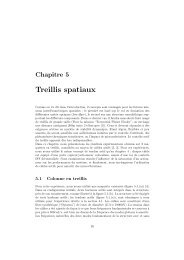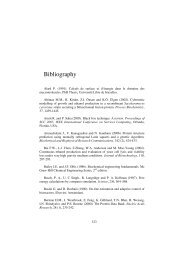Diapositive 1 - de l'Université libre de Bruxelles
Diapositive 1 - de l'Université libre de Bruxelles
Diapositive 1 - de l'Université libre de Bruxelles
Create successful ePaper yourself
Turn your PDF publications into a flip-book with our unique Google optimized e-Paper software.
Chapitre Valgorithms, skeletal Mg/Ca of past sea urchins were calculated according to theexperimental Mg/Ca solution and temperature (Figure 32). All calculated values were muchbelow the ratio measured in in vitro precipitated minerals. So, magnesium-specifictransport mechanisms should be involved in the <strong>de</strong>termination of the Mg/Ca ratio in thecalcifying space, probably lowering the magnesium concentration. In this context, itshould be noticed that in vitro <strong>de</strong>posits were grown from pure solutions of calcium,magnesium, carbonates and chlori<strong>de</strong>, whereas in nature, ions like sodium are veryprobably present and also influence also the properties of the precipitated biogeniccalcites (Morse & Mackenzie 1990).We recor<strong>de</strong>d a significant enhancement of magnesium incorporation in presence of SOMextracted from the sea urchin skeleton in comparison to precipitation experimentsperformed in absence of organic additive. This effect was not observed with BovineSerum Albumin, which indicates that the SOM effect was specific. Moreover, theenhancement of magnesium incorporation was more pronounced with SOM extractedfrom the test than with those extracted from the spines. The Mg/Ca ratio of P. lividus testbeing higher than the Mg/Ca ratio of the spines, this result further supports the hypothesisthat SOM has a specific effect on magnesium incorporation. This effect is probablymodulated by organic matrix composition and/or concentration.In<strong>de</strong>ed, amino acid compositions of sea urchin test and spine SOM were relativelydifferent, the test SOM containing more aspartate and glycine and less proline than thespines. High concentrations of glycine had already been reported in the skeletal organicmatrix of seastars (Dubois unpublished results, Gayathri et al 2007). Aizenberg et al(1996a) showed that this amino acid was more abundant in the amorphous than in thecrystalline phase of the spicules of the sponge Clathrina sp, and suggested itsinvolvement in the stabilization of such phases. Aspartic acid relative abundance was alsohigher in the test than in the spine SOM. Aspartic-rich proteins, which possess a domainthat possibly bind magnesium ions (Gotliv et al 2005), were suggested to play animportant role in the incorporation of this cation. Moreover, these proteins were shown tostabilize amorphous calcium carbonate (ACC) (Politi et al 2007) that affected magnesiumsignature of calcite (Loste et al 2003). In sea urchins, the saturation of such protein hasbeen suggested to limit the increase of magnesium incorporation with increasingtemperature (Hermans et al 2010b).105



